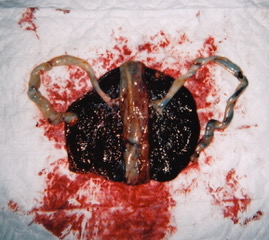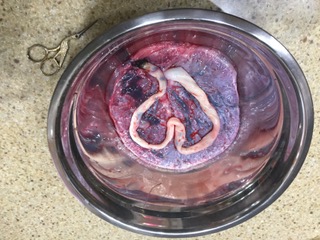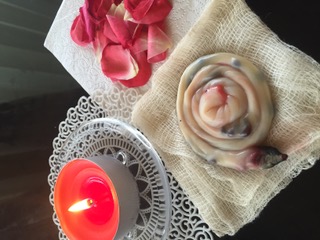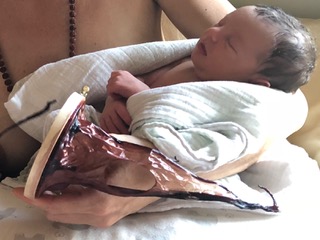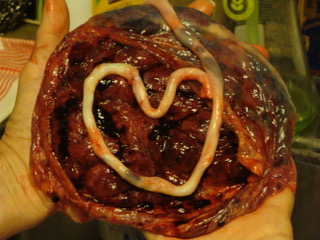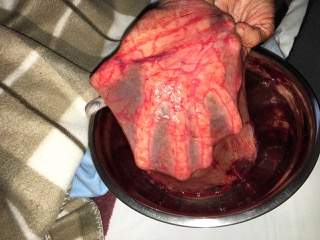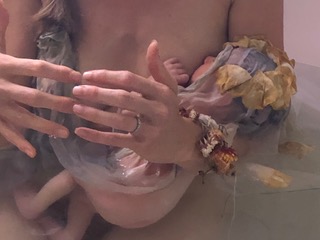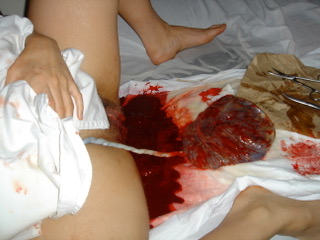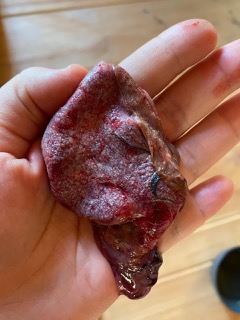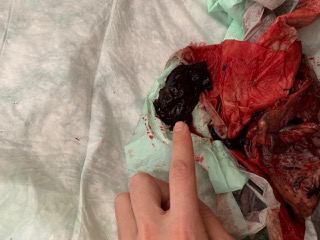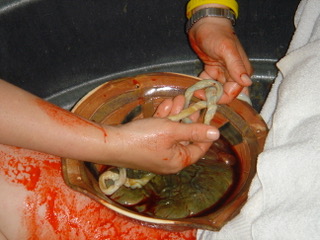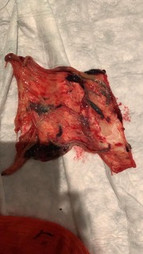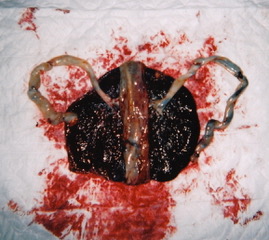Silent Hemorrhage
- Sister MorningStar
- Mar 22, 2023
- 19 min read
by Sister MorningStar
“But it didn’t hurt,” Beth told me straightforwardly as she cradled her sweet baby nuzzling in for a snack before nap at six weeks. I like to review births with mothers at various points during their postpartum, lying-in time. The 6-week or 40-day visit inevitably offers new perspectives. Beth had a herstory of excessive blood loss during childbirth. Knowing this, we designed a prenatal plan that included special herbs and diet to enrich her blood and strengthen her whole body system. We addressed dreams and fears and maternal family herstory. Despite our conscious team effort, it happened again.
Beth births like a quiet lion. She is protective of her newborn and it looks like a picture-perfect Hollywood birth film. Perfect until she opens up like a faucet and pours like the sky is falling. It took a 45-minute internal bimanual compression to give her body the time it needed to rebuild reserves and handle things on its own. She was nursing her baby while we engaged her with eye contact and questions to help her stay with us. Fortunately, the placenta birthed with the first gush.
I have always remembered her words to me. “But it didn’t hurt.”
Bleeding to death does not hurt. At least not from a uterine hemorrhage. I have never forgotten that. Pain is how we know to act on our own behalf. I wonder if that is why we hear the shuttering and tragic stories of mothers found dead and alone in huts or apartments from a delayed hemorrhage. I wonder. Were they just napping or nursing or dreaming of a better life when their life force just leaked away, carrying them with it, passively, painlessly? I wonder.
The prenatal plan we designed was successful in preventing repeat hemorrhage in other mothers. Why did it not work for Beth? I wondered. I kept listening.
“When I am bleeding like that, it is the only time Brian cares about me.” The tears swelled up in her eyes and the baby nuzzled in closer. So did I. I put my arm around Beth and got her another drink from the little table of snacks by her bed. Beth talked and cried and talked some more. “I like the look in his face and the sound of his voice that is really worried. I feel like he cares what happens to me.”
I had no remedy for that in my little midwifery bag. This is the work of the soul and intimate relationships, and maybe past lives, for all I know. The will to live is a powerful ingredient in overcoming obstacles like hemorrhage. Beth had one more birth. There was not one drop of extra blood as she birthed her placenta and swooped up her baby. She had done all the same precautionary and preparatory actions prenatally. She had hired the same midwives. She had birthed at home. She had changed two things: She labored alone in her bathroom and she chose a new partner. She named her little darling Dharma, rewrote herstory, and walked into a new life of personal power.
I wish there were a formula to avoid, respond, and repair the depletion caused by hemorrhage in childbirth. There is not. We are not robots. We are unique physical and spiritual expressions of a long line of experience. A hemorrhage can be a silent killer. I teach my students, “It isn’t how much blood a womyn loses; it is how she tolerates the loss.” That was the wisest education I learned regarding blood loss in childbirth.
I have seen robust wimyn dump four cups of blood, swing their legs over the bed, tie their shoelaces, and be on about their day—not wanting to alert the other children in the house. I have seen other robust wimyn lose little more than a cup and need help to stand and walk to the bathroom. I have seen sorely malnourished, anemic mothers offer up barely two tablespoons of blood, as if their body knew there was not a drop to spare. I have seen wimyn of all shapes, sizes, colors, ages, and parity surprise me when it comes to how their body manages blood loss. Only one fact remains constant: no two wimyn are alike and no one womyn births the same every time.
Each pregnancy deserves the close and devoted attention of someone who cares. The village midwife was that, and she is disappearing around the world. Her attention to the individual narrative has been lost to professionals who often know more about hemorrhage than they do about the mother they are serving. It matters if we want to help resolve excessive blood loss without endangering her reproductive future with compromising drug therapies. We need to know how to prepare, assess, respond, and recover. We need hand and heart skills to make that possible. We need the village midwife with her experience and wisdom.
Karli was pregnant with her fourth child. Karli had a herstory of fourth-stage delayed hemorrhage. The first had been handled with Pitocin. The second with herbs and Pitocin. The third with herbs and placenta. Each time, when she stood up, she went down. All had been followed by a long and depressingly weak postpartum recovery that affected milk supply. Karli knew she could birth triumphantly. She wanted to have a birth without a hemorrhage and all the extra tedious care that it requires. She changed midwives and focused on two things: 1) Prenatal care that included quarts of red raspberry and blackberry leaves; sprouts; pregnancy blend herbs; increased greens; extra calories for the extra workload; dreamwork; village prenatals; daily time alone in nature; and keeping her birth plan a secret. 2) Complete privacy, with plans to eat some of her placenta prophylactically, rather than waiting for it to be made into a smoothie. She did not stand the first day. Her midwife stayed the night and next day keeping vigil without disturbing her. It worked. No delayed hemorrhage. No need for lifesaving herbs or actions. No long recovery. What worked? All of it.
Carol had had a placenta accreta with her first homebirth, necessitating an emergency transport, scary blood loss, and surgical delivery of her placenta. Her second baby was stillborn in the late second trimester. She had been given a cesarean because her baby was breech and it was against hospital policy to do vaginal breech birth. She argued between premature contractions, as she was being wheeled to the surgical theatre. When she awakened from the general anesthesia, she was told she had had another accreta and surgical removal of her placenta. She held her lifeless baby in her arms, crying for many, many reasons. She was told her body would never do this right, that she should not have more children, and that absolutely she should never consider another homebirth. Carol’s fury was palpable. With her closest family in a circle around her, we buried that holy child on her land after he was returned from autopsy. Her desire and determination for homebirth was uncompromising. I researched sources from around the world and alternative therapies. Along with the prenatal regimen for avoiding excessive blood loss, we added homeopathic hydrastis. And prayer. The kind that is non-ceasing. Carol lived in a little trailer far from a paved road. I felt we needed a miracle. Carol felt she needed to birth her placenta. It was a waterbirth. The baby was born pink and lively. What happened next? Believe it or not, she birthed her placenta whole, healthy, and with no more blood than an herbivore deer in the forest. What happened after that? Carol asked for the phone. She called the hospital where her dead baby had been delivered by knife, the place where she had received a curse on her reproductive future. She said things that frighten fish and bring the dead to life.
Because of Carol’s bravery and insistence that I learn more and be more as a village midwife, I have been able to share this information with others. One mother in Russia, with a herstory of three placenta accretas, told me in tears, “Sister, I want to birth my placenta and not die. I want to birth at home.” I met her midwife. We talked for hours. We reviewed the preparatory plan and response plan. I shared what homeopathic hydrastis had done for Carol. The next year I returned to Russia. This same mother came running toward me. In one arm she cradled her homebirthed baby and in her bag—her placenta on ice. She wanted to show me her miracles. Both of them.
There are wonderful resources as well as full books on hemorrhage in childbirth, which tell us how to follow the flowchart to success. It is often very valuable information and every trick is worth remembering. But a birthing mother is a unique creature on this planet. She has a narrative unlike any other womyn. Many of her shadow issues or dark fears, demons, and desires may not be known to her until birth unravels and unveils them in a way like no other moment in her life. It is called the mini death by many village midwives. The womyn you were is no more. You walk through the portal door of then and there to here and now. That journey turns you inside out and spins you like a cosmic Milky Way. The river is flowing and carries a womyn to a distant shore. She is beyond fortunate if there is someone, even an ancestor, who is willing to get in that river and not just walk along the safe and sterile shore.
From nearly every continent and culture I have heard wimyn exclaim at birth, “I am going to die!” or “I thought I was going to die!” It’s a leap. What a privilege to witness that leap and see them land, like a big cat, on all fours and roar with their new self-claimed power. The power of a womyn.
That is the power that protects the new life they brought forth.
An unattended hemorrhage can be the end rather than the bright beginning of motherhood.
I was in Russia in 2015 or so, sleeping in a heavenly loft above a powerful woman from the United Kingdom whom I knew only by reputation. Her voice rocked me to sleep at night and called me to attention in the morning as she would open her computer, scowl, and curse the machine that brought her hundreds of emails from “blathering idiots!” She would, one by one, answer or dismiss them with no internal monologue that I could detect. This amazingly brilliant womyn is Beverley Beech—a birth activist and central figure for AIMS in the UK for decades.
I admired her openly and enjoyed our depth of dialogues. I was grateful when she came to several of my controversial sessions on home VBAC and other such topics at the Midwifery Today conference in Russia. She would interrupt me or a participant and say, “Stay home, girls! No matter what they tell you, it’s a lie! Stay home!” We stayed in touch and mourned together when our grandchildren were born by knife the same year. The Global Midwifery Council invited a discourse where a litany and laundry list of obstetrical abuses and violences were being collected. It ranged from inappropriate interventions, induction in VBAC, lack of evidence-based practice, protocols that ignore narratives, bullying, third-stage management, ignorance of delayed cord severing, separation of mother and baby, etc. Beverley concluded with a blunt fact that changed how I talk about wrongs. “Let’s not forget obstetric lies” was her final comment in that discourse.
Can we actually call a lie a lie no matter who says it? Beverley Beech can. I can.
It is not true that if you carry Pitocin, you don’t need to worry about hemorrhage.
It is not true that if you birth in a hospital or with professional midwives, they will know what to do about excessive bleeding and you don’t need to worry.
It is not true that if Pitocin won’t work, methergine will.
It is not true that hands-on skills are skills of unskilled midwives.
It is not true that you have to have blood work to know risk factors for anemia.
It is not true that anemic wimyn are going to hemorrhage.
It is not true that as long as you have a backup and live in 9-1-1 range, the help you need will arrive in time.
It is not true that if you take a certain herb, eat a certain diet, pray to a certain God, marry the right person, use the same doctor or midwife that your friend liked, you don’t need to think about excessive bleeding as a life-threatening danger.
It is not true that if you have never had a hemorrhage, you will never have a hemorrhage.
It is not true. It just isn’t true. Trust your direct experience. If it doesn’t match the data in the books, you are still right.
Andrea hiked the Sierra Leon; valued being strong, bright, and wild; was born in the USA, but ran a coffee business in Nicaragua when she reached out to me. She had been reading my book, The Power of Women, which was recommended by a trusted friend who had birthed at home. Andrea bravely wrote me an e-mail, not believing I would write back. She was pregnant with her first baby. The Leon hospital had a cesarean rate of 80%—higher for first-time mothers. They simply scheduled birth by knife. That was not for Andrea. She was bright and wild, but knew nothing about birthing babies. The doctor tried to scare her with the horrors and risks of natural birth, using obstetric lies. All Andrea could say was, “I don’t know anything about any of that, but there has to be some risk to you cutting me in half. I am going with the other risks.”
Andrea had her baby at home, with me on the phone for 13 hours. She birthed her little Lucille miraculously. But her placenta just hung around. Right at the cervix. Obstructing the full contraction of the uterus and causing a slow, painless bleed that lasted for hours. She was alone with her husband. Our connection was continually disrupted as electricity failed. I paced like a caged tiger, powering my breath of life into her, thousands of miles away. She was too unsure to “guide the placenta down and out.” She had read too often, “Never pull on the cord.” Ultimately, weak, unable to stand, coming in and out of consciousness, she transported and the issue was resolved forthwith.
Why did Andrea nearly bleed to death? Why do birthing humans, unlike their mammalian sisters, too often bleed to death or experience such unnecessary excessive bleeding? It is such an important question. Andrea and I did her birth review—by phone, of course. I learned more of her story. Her mother-in-law had nearly bled to death in childbirth. The whole family was raised with the story. Her partner had been scared “to death” that Andrea would also bleed. I seldom meet a man that doesn’t nearly faint at the sight of blood, much less shudder at the thought that womyn bleed monthly and do not die. Yes, the holy blood at birth is generally too much for a man’s eyes. Add fear to that and, well, that was what was in the birth room for Andrea.
Since then, I regularly have folks watch the chimpanzee birth at the Attica Zoological Park, where the mother and midwife work as an incredible team. It shows multiple upright positions, crowning, self-touching, birthing a limp baby, drinking amniotic fluid (which hydrates, energizes, and helps birth the placenta), newborn resuscitation (using the five universal maternal behaviors I teach in NewBorn First Breaths), pulling out her own placenta, and then telling the midwife to back off. It is the only birth film I strongly encourage pregnant mothers to watch. It goes into their old brains and they act like primates, which they are. It saves lives.
Katerina had birthed her first child in a foreign government hospital that did not allow anyone to accompany her. She, like every other womyn I talked with in that country, could not or would not speak of what had happened to them in the hospitals. “Too horrible,” they would say. “Better to not think about it.”
Katerina birthed her second son at a popular birth center in a freer country, with caring midwives but without her family. She longed to birth in her homeland, with her husband and children around her. She longed to experience something sacred and wonderful. Something worth talking about. A herstory worth passing on. After soul-searching, and maybe the intervention of angels and ancestors, there we were, together, helping her dream come true. Katerina birthed like a queen. The baby was born with a regal cape of cord around both shoulders, holding him in place as the holy mother took all the time she needed to gaze and touch and drink in her bliss. Those of us who held sacred witness bowed in honor, lifting up a silent prayer of gratitude the likes of which only issue forth from the soul in hard-won victories. We waited. I waited. Nothing to rush. No herstory of third-stage problems, excess bleeding, prolonged or delayed or abrupted or adherent or whichever of the oddity names of placenta. No signs of a concealed bleed. Just pure happiness.
Suddenly, out gushed the red river, wave after wave after wave. Pushed by some unseen force. A midwife can jump in and take action and sometimes must. But if the mother can take action, she becomes the one empowered. which can be lifesaving long after the midwife goes home. “It doesn’t hurt to bleed,” I remembered. Before Katerina could become weak and unable, I midwifed with word medicine. “Take hold of the cord and be like the chimp. Close your eyes and be the primate.” She took hold, closed her eyes, held her baby tight, and drew the placenta down and out. All bleeding stopped and she was left with a baby in one hand and a placenta in the other. Triumphant!
We used a piece of that placenta as extra insurance. She kissed her baby all over, getting some of the amniotic fluid in her lips and mouth. We had in-home help for weeks, and special foods and herbs to rebuild her vitality and stamina to last into her crone years. Every mother needs a tribe. Sometimes of her own making.
When wimyn take hold and bring out their own placenta, they know exactly how much force to use. They can feel what is happening from the inside. If the placenta doesn’t birth on its own, they are the superior midwives for controlling the cord, relaxing their bottom, tilting the pelvis just so (in or out of the water), and guiding the placenta down and out. As midwives, we have to think about using the power in our wrist movement and not our elbow. We must watch for length of cord, change in blood flow, grimace or disturbing sounds by the mother, a feeling of resistance, and whether that is from a closed cervix or adherent lobe and so on. The mother’s old brain and visceral body is in a perfect biofeedback loop that makes her the superior self midwife in that moment. Teach her. You will become a believer, like me, and we will save more lives around the world.
Just because a placenta doesn’t birth in a timely manner doesn’t mean the mother will bleed. I have seen placentas take five, six, or seven hours to birth. One was 13 hours later. There was no extra blood. It just wasn’t ready. I wonder if it was an absorbed twin with a different gestational age. Some questions just can’t be answered. I am a keeper of sacred story and birth is the richest of those treasures.
I digress. May we keep the stories alive. They hold the facts. Silent hemorrhage is real. It is the most common birth complication. Join me as I quote my great colleague and traditional midwife, Doña Antonia. “Us wimyn, we are going to die. But we are not going to die in childbirth.”(1)
Risk Factors for Hemorrhage and What You Might Do.
Prenatally
Narrative—Listen to her story over and over again, however she wants to tell it.
Reproductive herstory—Take notes and ask questions. How was she born? Her mother? Her grandmother? Are there generations of surgical and medicated birth affecting DNA, psyche, and tribal story? Has she ever been pregnant before? How was she birthed and why?
Biological Maternal herstory—Review and review.
Current Health—Help her improve it, whatever it is.
Living Environment—Spend a day with her. Walk, eat, sit at her sofa and table.
Nourishment—Ask for a seven-day food log every trimester.
Elimination—It’s just as important as what goes in. How often? How much?
Sleep Habits—Ask at every visit. How many hours? Naps? Quality? Up to pee and snack?
Supplements—Assess what she is taking and why. Are the herbal singles or compounds? Do they match her ethnicity, taste, budget? Why make a suggestion that will not work for her? Find what will work. Maybe it is growing right outside her door (2).
Scars—Assess outward and inward. Hair to toe. Do they heal? Bleed? Hurt?
Prescriptive medications—What and why, past and present. Mother, partner, and female siblings.
Ethnicity—What and where is her homeland, family, culture, beliefs?
Postpartum plan—Begin designing in the first trimester. Prepare for extra needs.
Fears—Dive into hers, her partner’s, her mother’s, anyone close around her or planning to be at the birth. Thoughts are things. Feelings are things. Fear is a thing.
Bleeding—gums, wounds, cycles, etc. Assess and support with iron rich foods/supplements.
Anemia as potential contributor—Observe clinically her nail beds, lips, skin. Build blood with such as soaked prunes, apricots, raisins; black strap molasses; dark leafy greens; any green food she will eat (3).
Previous PP hemorrhage—Ask a thousand questions about pregnancy, interventions, management, followup, etc. (I actually know a case where the mother had a surgical delivery and she bled because the incision had not been adequately cauterized, needed multiple blood transfusions and a repeat surgery within seven hours. It was charted as a PP hemorrhage. Technically true, right? No, it is a lie. Both to this mother, her children, her tribe, and the medical students in education.)
Third-stage management, previous—In her or her mother, has the message to the uterus to release a surge of oxytocin upon birth been turned off by artificial pre-emptive drug management for “hemorrhage prevention” and forced placental delivery? Like someone who uses colonics to poop, pretty soon you can’t. This information is critical in preparing for, helping to avoid, and responding to a possible third-stage bleed. Or fourth. Or beyond. Into her children and her children’s children. The encoded intelligence is still there. Build up her body and instinct, spend extra time in nature, encourage breastfeeding, avoid interventions, plan to give extra time for third stage, plan to use placenta immediately.
Stress—Decrease her stress and increase her immune/hormonal response by helping her find a way to spend unrushed, unobserved time in nature. In St. Petersburg, Russia, we used bathtubs, showers, and going down to ground floor at night to walk outside and howl at the moon. Get creative. She needs her feet on the ground and her spirit clean to offset nature deficit disorder and build a strong healthy system that can avoid or deal with hemorrhage.
Birth of baby and placenta
An exhausted mother will often have a tired uterus. Use rest, hydration, and nutrition and be prepared.
Prolonged first stage—find out why.
Avoid inductions (even herbal), augmentations (even herbal), extractions, or c-sections.
Undisturbed birth helps.
Unrushed birth helps.
Privacy, but not abandonment, helps.
Use nature and the four elements: earth (open air walking on uneven terrain), air (vocalizing and word medicine), fire (candles or fire circle or sun, moon, stars), water (bath, shower, rain). Instinctual birthing helps.
Keep hydrated. Drink to thirst and empty the bladder every two hours. Drink nutritive teas of red raspberry, blackberry, pregnancy blends, juices of berries or apricots, and miso soup, broths, etc.
Nipple stimulation/nursing.
Use of amniotic fluid, cord, or placenta, both prophylactically or in response to blood loss.
Herbs like angelica root to encourage release of the placenta. Each culture has favorite herbs. Be very familiar with the allies and aids you use. Anyone can be allergic to anything.
Herbs or homeopathics, such as shepherd’s purse, to buy you time. I have even used cinnamon (4).
Keep mother and baby together and have mother talk to baby and to her body.
Persistent gush or slow leak
Assess origin
Is placenta born? Use upright position, herbal/food support, confidence, and gentle traction (best by the mother). If you have blood from the uterus, the placenta is trying to be born. Do you need to do a manual removal of the placenta?(5)
Administer a piece of the placenta in the mother’s cheek or between graham crackers. If the cord is long, she can chew it. Do not cut the cord. Kissing or licking the baby will get some of the amniotic fluid in her. Anything from her placenta will help her uterus contract and help control the bleeding.
Check for firm uterus below mother’s umbilicus.
If soft and with bleed, begin external or internal bimanual compression. You can help the uterus stay contracted until it has the strength to do so on its own.
Engage the mother’s participation. Talk to her. Keep eye contact.
Continue all support until bleeding is controlled.
Praise the mother. Together you handled a challenging complication and she is now stable and home and can enjoy her baby and a special recovery period. You, too.
If the bleeding cannot be controlled, seek help. This is not a teaching about such complications as accreta, partial abruption, or unusual blood disorders.
Postpartum following hemorrhage
Do not leave her alone. Stay an extra 12 hours or more. Role-model the care she needs.
Make sure she is never alone the first three days and that someone is with her to toilet. She can crawl if she cannot walk and pee on pad if she cannot crawl.
Watch for any sign of infection. Increase immune-boosting foods and herbs.
If the baby sleeps, she sleeps, If the baby eats, she eats.
Extra time and help are needed. The support team needs to understand this (6).
Find out what tasks she usually does daily, weekly, monthly. Help her design help for this and child care and domestic chores. This plan is designed prenatally but must be embellished. Community, church, family outreach are invaluable resources and superior to professional or agency help.
Add extra iron-rich foods to the daily diet. Soaked prunes and apricots and raisins, molasses and peanut butter, sprouts, leafy greens, smoothies, beets, oatmeal, scrambles with cheese and veggies, etc.
Place three sources of fluids by her bed with a snack that is refreshed every two hours. Maybe tea, juice, water and grapes, nuts, yogurt, PBJ, finger foods. Make every bite count.
Consider a daily plant-based iron supplement.
The herbal bath and yoni steam must wait for signs of strength. Help her with a bird bath. Being refreshed is refreshing to the body, mind, and spirit.
Listen to her birth story. Answer questions. Praise her.
Increase your postpartum calls and visits. Ask her how she feels she is doing and what she needs.
Add supportive therapies according to her budget and comfort: aromatherapy, massage, etc.
Put a pot of water on the stove with some essential oil or something that smells good and is uplifting and purifying as well as calming.
Open the windows or curtains and get her some fresh air and some sunshine. Baby needs it, too. Maybe there will be birds singing. The night sky can be very soothing, too, since she will be up nursing. Remember to keep a bedside table with fresh drinks and snacks at all times.
Recovery will be 8–10 weeks rather than 6. This is an ideal time to rebuild for a lifetime. Prolapsed bladder and uterus in later life can often be traced to childbirth where the mother was up and about too soon. There is wisdom in not lifting anything heavier than the baby, not vacuuming, delayed intercourse until after recovery, plenty of sunshine, and sisterhood.
Recovery is complete when she is radiant, strong, communicative, and eager to resume her full participation in life. If something is lacking, help her identify it.
Share the story.
NOTES
That reminds me of a story. Umsahlama was working at a tertiary care hospital in Atlanta. The teenage mother birthed her baby and began to bleed. Umsahlama immediately performed an internal bimanual compression as she called for IV Pitocin. She was written up for not re-gloving prior to entering the uterus. “I am not going to hold a dead body. Infection I can treat. What am I supposed to do with the dead?” said the wise African American, Umsahlama.
The first winter I served the Mennonite population I made the mistake of recommending eating leafy greens to build rich blood. The father looked out the window at the deep snow and remarked, “Well now. There wouldn’t be anything like that growing in these parts about now.” We started growing sprouts on the window sill instead.
True Story: my first year working in Mexico with various village dialects I made the mistake of trying to tell the pale-faced, dark-skinned, overworked mothers to eat more green food. They resisted and called in Doña Antonia, the Director of the small NGO Maternity Hospital run by C.A.S.A in Guanajuato, Mexico. Doña Antonia explained the problem. “Estrella, you are telling them to eat unripe food and they will not do it. They know it will make them sick. Just say eat more nopal (cactus leaves) and beans. That will get them the iron and protein they need and it is within their budget and they will do it.” See why we need village midwives!
Food can be a medicinal ally or alterative.
The only time I had to was during a miscarriage.
If the mother has not had replacement fluids, she will be weak and hungry and want to stay in bed. Her family will not expect her to do as much. If she has replacement fluids and appears to be strong, they will think she is. She will think she is. But she isn’t. Her body needs time to rebuild the lost red blood cells and more. She will crash later when all help has gone.

